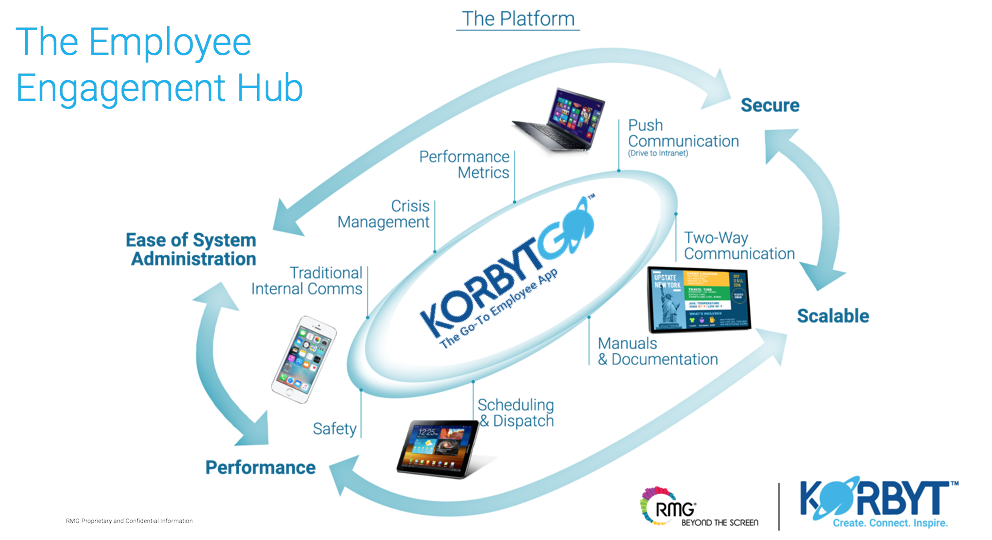How a Content Management System Can Yield Effective Corporate Communication

How a Content Management System Can Yield Effective Corporate Communication

Jerry Rosen
The key to employee engagement is effective communication. But “communication” is no longer black and white. It has morphed into a massive vortex of rapid-moving tidbits available via numerous channels.
Communication is pushed, pulled, shared in real time and at times superfluous. But this poses a problem when considering effective communication is the key to cultivating employee engagement.
The DSF recently had an opportunity to learn how one member, RMG Networks, is trying to cut through the noise with its new platform, Korbyt.
Jerry Rosen, Senior Vice President, Global Chief Marketing and Creative Officer of RMG Networks, said effective corporate employee communication can be enabled by converging technology, strategy and content.
“I look at corporate communications through a lens of internal marketing and advertising,” Rosen said.
That may be a natural fit for the former advertising executive. He has helped drive RMG’s consultative approach, helping customers define engagement and facilitating employee connection.
“We focus our customers on personalization,” Rosen said. “We create engagement and try to help our customers create or identify inflection points where messaging can be done at the right time, to the right people, in a rotation of content that impacts them.”
The ultimate goal is employee retention and engagement. The core technology used by RMG in its approach is the Korbyt management platform. RMG has been developing its own methods and nomenclature around employee behavior and use those resources to help customers plan how messaging is distributed and scheduled. One of those ways is by embracing the unchangeable fact that employees use their mobile devices.
Personalizing the message
While discussing how to put out relative and effective messaging content, Rosen said that digital signage content often lags behind the pace of the enterprise.
“That is one advantage of a system that integrates mobile into the messaging. We reversed the technology road map starting with mobile personalization. Increasingly growing remote workforce has created the demand for personalize content employees can access anywhere, anytime. Is based on mobile content threaded through the desktop and onto signage,” he said.
There is a governance process surrounding the multi-direction dissemination and creation of content. This involves a process of legislating policy for proper and relevant content, monitoring content and curating it for appropriate use.
“The goal is to filter content but encourage honest dialogue. Corporate (communication departments) can push key messaging but should allow group content sharing. This need for content means that employee generated items such as pictures, videos and storytelling are organic fields for continuous fresh and relevant content.” Rosen said.
One challenge with communication in a digital signage environment has been audio. Video with audio is better applied to 1:1 devices like computers and mobile devices. Short videos without audio on public video displays can encourage employees to see the longer videos on desktops and mobile devices. One type of video content which proved to have success was messaging from corporate leaders. RMG piloted CEO videos with this approach and through analytics discovered that the average length of a CEO video should be less than 60 seconds when applied to non-crisis or urgent business messaging. The pilot was based on non-crisis, non-urgent event sharing.
“These videos can be very effective in messaging but require the right context,” Rosen said. “We’re able to see real-time performance metrics including who opened, saw, and watched these videos by department.” Those metrics in turn help the enterprise understand what most interests their employees.
The corporate communications professional
The accelerated growth of the use of video means the role of the corporate communication professional requires multidisciplinary skills. The challenges they face and variety of communication medium at their disposal mean that internal communication professionals now have omni-channel responsibilities, Rosen said.
Internal communications is a growing hiring category for many companies. RMG is seeing some enterprise customers assign ‘beat reporters’ or designated content contributors. These focused contributors feed the voice of their region or department into corporate communications via employee spotlights, anniversaries, recognition, and other newsworthy items which build the corporate culture.
Using corporate communications to help move employees from passivity to engagement can be supported by digital signage messaging. “The objective is to move employees from ‘I don’t know’ to ‘I know what’s going on and still don’t care’ and finally to ‘I know and I care!’ That’s the key – move from ‘get heard’ to ‘get change’” Rosen said.
Internal communications benchmark study
This year, RMG, along with Ragan Communications, has published an internal communications benchmark study that includes over 300 full responses from stakeholder involved in employee communication.
Key findings from the study include:
• Employee engagement is notoriously hard to measure, which poses a challenge for both HR and communications teams. Technology – such as self-service and pulse feedback tools – is enabling employers to communicate in new ways to establish a more holistic employee engagement approach. It is important to understand how to best use these technologies to drive engagement and choose the right platform(s) that aligns with your business goals. A content management system, for example, enables individuals to publish content across multiple channels.
• To enable powerful internal communications, the ability to receive real-time feedback can allow an ability to gain insights about your employees. Knowing what percentage of employees accessed the content, how many people watched the video, if it was accessed across all departments, etc., can help better enable communication across the organization.
• It is important for employees to feel compelled to act on the messaging they are receiving from internal communications. This can be done by applying user segments for tagged content to create personalized messaging. With Korbyt, for example, these tags can include roles, channels, teams, departments and more. Employees want to see content that will impact them directly, therefore employers need to be able to easily share content that is specific and relevant.
• Having a scalable CMS platform can better enable employers to create, manage and deploy content across a variety of endpoints, including mobile apps. The key to messaging is that they are consistent and consumable. As the study notes, CMS platforms can be a gateway to creating a truly interactive employee experience.






